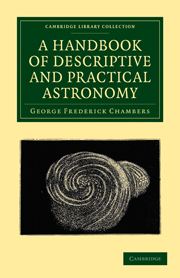Book contents
- Frontmatter
- PREFACE
- SUPPLEMENT
- Contents
- LIST OF ILLUSTRATIONS
- PRINCIPAL AUTHORITIES
- Errata
- A Handbook of Descriptive and Practical Astronomy
- BOOK I A SKETCH OF THE SOLAR SYSTEM
- BOOK II ECLIPSES AND THEIR ASSOCIATED PHENOMENA
- CHAPTER I GENERAL OUTLINES
- CHAPTER II ECLIPSES OF THE SUN
- CHAPTER III THE TOTAL ECLIPSE OF THE SUN OF JULY 28, 1851
- CHAPTER IV THE ANNULAR ECLIPSE OF THE SUN OF MARCH 14–15. 1858
- CHAPTER V THE TOTAL ECLIPSE OF THE SUN OF JULY 18, 1860
- CHAPTER VI HISTORICAL NOTICES
- CHAPTER VII ECLIPSES OF THE MOON
- CHAPTER VIII SUGGESTIONS FOR OBSERVING ANNULAR ECLIPSES OF THE SUN
- CHAPTER IX TRANSITS OF THE INFERIOR PLANETS
- BOOK III THE TIDES
- BOOK IV MISCELLANEOUS ASTRONOMICAL PHENOMENA
- BOOK V COMETS
- BOOK VI CHRONOLOGICAL ASTRONOMY
- BOOK VII THE STARRY HEAVENS
- BOOK VIII ASTRONOMICAL INSTRUMENTS
- CHAPTER I TELESCOPES
- CHAPTER II TELESCOPE STANDS
- CHAPTER III THE EQUATORIAL
- CHAPTER IV THE TRANSIT INSTRUMENT
- CHAPTER V OTHER ASTRONOMICAL INSTRUMENTS
- CHAPTER VI HISTORY OF THE TELESCOPE
- BOOK IX A SKETCH OF THE HISTORY OF ASTRONOMY
- BOOK X METEORIC ASTRONOMY
- APPENDICES
- INDEX TO SUBJECTS
- INDEX TO NAMES
- Plate section
CHAPTER IV - THE TRANSIT INSTRUMENT
Published online by Cambridge University Press: 05 July 2011
- Frontmatter
- PREFACE
- SUPPLEMENT
- Contents
- LIST OF ILLUSTRATIONS
- PRINCIPAL AUTHORITIES
- Errata
- A Handbook of Descriptive and Practical Astronomy
- BOOK I A SKETCH OF THE SOLAR SYSTEM
- BOOK II ECLIPSES AND THEIR ASSOCIATED PHENOMENA
- CHAPTER I GENERAL OUTLINES
- CHAPTER II ECLIPSES OF THE SUN
- CHAPTER III THE TOTAL ECLIPSE OF THE SUN OF JULY 28, 1851
- CHAPTER IV THE ANNULAR ECLIPSE OF THE SUN OF MARCH 14–15. 1858
- CHAPTER V THE TOTAL ECLIPSE OF THE SUN OF JULY 18, 1860
- CHAPTER VI HISTORICAL NOTICES
- CHAPTER VII ECLIPSES OF THE MOON
- CHAPTER VIII SUGGESTIONS FOR OBSERVING ANNULAR ECLIPSES OF THE SUN
- CHAPTER IX TRANSITS OF THE INFERIOR PLANETS
- BOOK III THE TIDES
- BOOK IV MISCELLANEOUS ASTRONOMICAL PHENOMENA
- BOOK V COMETS
- BOOK VI CHRONOLOGICAL ASTRONOMY
- BOOK VII THE STARRY HEAVENS
- BOOK VIII ASTRONOMICAL INSTRUMENTS
- CHAPTER I TELESCOPES
- CHAPTER II TELESCOPE STANDS
- CHAPTER III THE EQUATORIAL
- CHAPTER IV THE TRANSIT INSTRUMENT
- CHAPTER V OTHER ASTRONOMICAL INSTRUMENTS
- CHAPTER VI HISTORY OF THE TELESCOPE
- BOOK IX A SKETCH OF THE HISTORY OF ASTRONOMY
- BOOK X METEORIC ASTRONOMY
- APPENDICES
- INDEX TO SUBJECTS
- INDEX TO NAMES
- Plate section
Summary
By far the most important of what may be termed the miscellaneous astronomical instruments is the Transit, or Transitcircle, the smaller and less perfect kinds being chiefly used for taking the time, and the larger for measuring the positions of stars, &c, for forming catalogues.
We shall only describe the small, or portable, transit. The instrument consists of three principal parts, the telescope, the stand, and the circle: a b, is a telescope of a large field and low power, the tube of which is in 2 parts, connected by a cubical centre-piece, into which, at right angles to the optical axis, are fitted the larger ends of 2 cones, c, c, which form the horizontal axis of the telescope, the smaller ends of each cone are accurately ground to z perfectly equal cylinders, or pivots. These pivots rest on Y's, angular bearings, which surmount the 2 side standards, e and w, of which e may be called the eastern, and w the western. One of the Y's is fixed in a horizontal groove, so that, by means of a screw, a small azimuthal motion may be imparted to the instrument; in like manner a small motion in altitude may be obtained by turning the foot screw g. On one end of the axis is fixed, so that it may revolve with it, a decimation circle, d, divided to degrees and read by verniers to minutes, &c.
- Type
- Chapter
- Information
- A Handbook of Descriptive and Practical Astronomy , pp. 346 - 354Publisher: Cambridge University PressPrint publication year: 2010First published in: 1861



